#Darraðarljóð
Text
youtube
Lyrics (source):
Bræðr munu berjask ok at bǫnum verðask,
munu systrungar sifjum spilla.
Skelfr Yggdrasils askr standandi,
ymr it aldna tré, en jǫtunn losnar.
Vindum, vindum
vef Darraðar,
þars vé vaða
vígra manna;
látum eigi
líf hans farask,
eígu valkyrjur
vals of kosti.
Vítt es orpit
fyr valfalli.
Vítt es orpit
fyr valfalli
rifs reiðiský,
rignir blóði.
Translation:
Brothers will fight one another and kill one another,
cousins will break peace with one another.
Yggdrasil still stands, but it trembles,
the old tree sighs when the giant shakes it.*
We wind and wind
the web of spears,
there where the banners
of bold men go forth;
we must not let
his life be lost –
valkyries decide
who dies or lives.
A wide warp
warns of slaughter.
A wide warp
warns of slaughter;
blood rains
from the beam’s cloud.**
Translation by *Jackson Crawford (for Vǫluspǫ) and **Robert Cook (for Darraðarljóð).
0 notes
Note
Also there's an old norse saga where the valkyries sing and weave with the entrails of fallen men 😌😌 https://en.m.wikipedia.org/wiki/Darra%C3%B0arlj%C3%B3%C3%B0
Excellent yes very good! For everyone's benefit, bold emphasis mine:
Darraðarljóð is a skaldic poem in Old Norse found in chapter 157 of Njáls saga. It consists of 11 stanzas recounting the vision of a man named Dörruð, in which twelve valkyries weave and choose who is to be slain at the Battle of Clontarf (fought outside Dublin in 1014). Their loom uses human entrails as warp and woof, swords as treadles, an arrow as the batten and men's heads as weights. Of the twelve valkyries weaving, six of their names are given: Hildr, Hjörþrimul, Sanngriðr, Svipul, Guðr, and Göndul. Stanza 9 of the song has been translated:
Now awful it is to be without,
as blood-red rack races overhead;
is the welkin gory with warriors' blood
as we valkyries war-songs chanted.
The poem may have influenced the concept of the Three Witches in Shakespeare's Macbeth.
Dörruð's vision is located in Caithness and the story is a "powerful mixture of Celtic and Old Norse imagery".
--Darraðarljóð - Wikipedia
6 notes
·
View notes
Text
Er hin gullna stjarna skýjar slóðar rennr rauð
Er hin gullna stjarna skýjar slóðar
rennr rauð, grænt ok svart rennr þá
landið þat er sér engan endi á. Á þeirri stundu,
hinn dokkvi leikr vígnaðrs stafa brýst út. Á
þeirri stundu, kaldir fýris garmar dansa sinn
dans við anda nætur. Fylgjendr Hvíta Krists
veita mér eftirfor er þeir sjá mik flýja inn í nót-
tina. En þat er um seinan, hún hverfr í heiðna
holl sem er þeim hulin.
Troll kalla mik,
tungl sjot-Rungnis,
auðsúg jotuns,
élsólar bol,
vilsinn volu,
vorð náfjarðar,
hvélsvelg himins.
(Anonymous Stanzas from Snorra Edda,
Stanzas from Snorra Edda 9)
Era auðþeystr,
því at ekki veldr
hofugligr,
ór hyggju stað
fagnafundr
Friggjar niðja
ár borinn
ór jotunheimum.
(Egill Skallagrímsson, Sonatorrek 2)
Ek ráfa um auðlegan stað einsomul. Úr fjarska
heyrast oskrin, en þetta skjól skógar tryggir
mik frá stríðs ræðu þeirri. Silfruð sunna leiðir
mik á veg minn, norðr upp sem Ullar aksþollar
hvísla birtleg orð segjandi frá rigandi hræ-
mána úr ok feigð minna niðja. Fylking sú er í
nóttinni ferðask ok nálgask mik, mér er boðið
at fylgjask at til Yggjar brúðar, hvar sogð er sú
spá af dansandi benvondum brátt rísandi. Til
hjálpar þeirra er ljósið sjá nema um daga, oðru
sinni á ný. Óláfr, þrænda buðlingr í þessu landi
viða. Óláfr, berandi bitra stríða, þeirra er sér
engan endi eigan, Óláfr, dómr nam óma at þings
viðjum þar aldregi fallið hafði fyrr. Er þetta þín
spásýn? Er sá hjálparlaus mergjar salr frá þangs
láði lifandi, er sú biðjandi haukar ferja í lundi-
num lifandi?
Vítt es orpit
fyrir valfalli
rifs reiðiský,
rignir blóði;
nú er fyirr geirum
grár upp kominn
vefr verþjóðar,
er þær vinur fylla
rauðum vepti
Randvés bana.
(Anonymous Poems, Darraðarljóð 1)
Skapt mun gnesta,
skjoldr mun bresta,
mun hjalmgagarr
í hlíf koma.
(Anonymous Poems, Darraðarljóð 3)
Framm skulum ganga
ok í folk vaða,
þar er vinir várir
vápnum skipta.
(Anonymous Poems, Darraðarljóð 4)
Vindum, vindum
vef darraðar
ok siklingi
síðan fylgjum!
(Anonymous Poems, Darraðarljóð 5)
Vindum, vindum
vef darraðar,
þars vé vaða
vígra manna!
Látum eigi
líf hans farask;
eigu valkyrjur
vals of kosti.
(Anonymous Poems, Darraðarljóð 6)
Bróðir, þér lífit, ek finn þat nú bitrleg storm ský
dólgbrands dokkva safnask at Stiklastoðum.
Nú er ógurligt
um at lítask,
er dreyrug ský
dregr með himmi;
mun lopt litat
lýða blóði,
er sóknvárðar
syngja kunnu.
(Anonymous Poems, Darraðarljóð 9)
English: When The Golden Star Of The Sky Turns Red
When the golden stars of the sky
turns red, the never-ending land of
green turns black. At this time, cold winds dance
their dance with night spirits. Followers of the
White Christ chase me as they see me fleeing
into the night. But it is too late, as I vanish into
pagan castles unseen to them.
They call me troll, moon of dwelling-Rungnir,
wealth-sucker of a giant, trouble of the storm-
sun, delightful company of a prophetess, guar-
dian of the corpse-fjord, swallower of the wheel
of the sky.
(Anonymous Stanzas from Snorra Edda, Stanzas from Snorra Edda 9)
Since heavy sobbing is the cause - how hard to pour forth from the mind's root the prize that
Frigg's progeny found, borne of old, from the world of giants.
(Egill Skallagrímsson, Sonatorrek 2)
I wander a forlorn path alone. From afar, scre-
ams are heard, but this wooden shelter protects
me from the speeches of war. The silver sun
guides me on my path up north as trees whisper
bitter words telling of a rain of blood and my kin
to be slain. When I am approached by a band of
night travelers, I am invited to follow to a place
where the prophesised dance of swords will soon
emerge. To help those who see the light of days
a second time again. Óláfr, king in this land of
wood, Óláfr, bringer of bitter wars that never
end. Óláfr, impending doom to trees that never fell before. Is this your prophecy? Is the helpless
hand from the sea alive, is the praying hand from
the grove alive?
A wide warp warns of slaughter, blood rains
from the beam's cloud. A spear-grey fabric is
being spun which the friends of Randvér's slayer
will fill out with a red weft.
(Anonymous Poems, Darraðarljóð 1)
Shafts will splinter, shields shatter, the dog of
helmets devours shields.
(Anonymous Poems, Darraðarljóð 3)
Let us go forth amongst the fighters when our
dear ones deal out blows.
(Anonymous Poems, Darraðarljóð 4)
We wind and wind the web of spears and then
stand by our stalwart king.
(Anonymous Poems, Darraðarljóð 5)
We wind and wind the web of spears, there whe-
re the banners of bold men go forth; we must not
let his life be lost - valkyries decide who dies or
lives.
(Anonymous Poems, Darraðarljóð 6)
Brother, you are alive, I feel it now as the bitter
storm clouds of blood gather at Stiklastaðir.
Now it is gruesome to gaze around as blood-red
skies cover the sky; the heavens will be garish
with the gore of men while the slaughter-war-
dens sing their song.
(Anonymous Poems, Darraðarljóð 9)
#Árstíðir lífsins#Arstidir Lifsins#International#Iceland#Germany#Pagan Black Metal#Black Metal#Bandcamp
0 notes
Text
The Norns in Old Norse Mythology by Karen Bek-Pedersen
Dunedin Academic Press Ltd, 2011
224 pages, including index and extensive bibliography
With impeccable timing, my copy of this book (ordered directly from the publisher) arrived a few weeks prior to the deadline for the Jotnar-themed issue of Idunna, the magazine of The Troth, where this review first appeared.
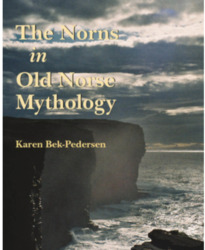
The book is based on the author's doctoral thesis. While expanded for a broader audience, it is still a chewy work, giving the reader much to consider, without being unreadable in its thoroughness. All references to other works are clearly and understandably noted, and the endnotes to each chapter add useful information without bogging down the main text.
She acknowledges what all of us who engage in research keep in mind as we do our work:
"It should not be imagined that Old Norse mythology, world view and traditions were ever static; culture is a continuous process, not a finished product."
Page 3
Bek-Pedersen begins with a discussion of the difficulty of defining the Norns, in relation to, and distinct from, other powerful female figures—disir, valkyrur, fylgjur, and volur. While there is overlap between the Norns and each of the other figures, she finds sufficient material in the sources to establish the Norns as a unique type. This in particular stood out as I was reading:
"Nornir rarely appear in person but it is common for volur to do so, and it seems fair to say that nornir are generally conceived of as distant, intangible beings who go about their tasks somewhere beyond human reach while volur, where these are described as physically present in human society, represent a more comprehensible version of similar otherworldly knowledge. Volur nevertheless always retain some otherworldly quality. In this way, volur and nornir may actually represent similar notions, only in different formats or on different levels."
Page 60 - Page 61
The volva as a messenger from the Norns—does this sound like Oracular Seidhr, or what?
She then moves to a discussion of the names as we currently know them—Urd, Verdandi, and Skuld—and their domains of past, present, and future. Surprisingly, there is not a great deal of support in the the Lore for this particular set of names, nor for the past/present/future attributions, despite these being so common in modern practice. Her conclusion is that, while each region had its own myths and aspects for the spirits and deities, the similarity of these associations seems more like a later imposition, bringing in the qualities and associations with the Fates by those educated in classical Greek or Roman myths. That may be, but the names and temporal associations work quite well, so I'm going to continue with it in my practice.
The fourth chapter contains a discussion of the Norns and their associations with textile work. The chapter opens:
"The fact is that textile and textile work are in many ways good metaphors for how the concept of fate operates. But the fact is also that there are no clear-cut and unequivocal representations of the nornir engaged in spinning or weaving to be found anywhere in Old Norse literature. This could be due to accidental loss of parts of the tradition—the source material that survives is not necessarily representative of the tradition as a whole. On the other hand, we can only work with what we actually have and, in spite of the general tendency to discuss them, we do not have any spinning and weaving nornir."
Page 123
I'm sensing another incursion of Western Classical Education.
She continues:
"There are, however, three texts that come close and, although none of them constitutes firm evidence, they all merit some disussion here."
Page 123
Perhaps there is hope!
She then analyzes the mentions in Volundarkviða, Beowulf, and Darraðarljóð. She notes that:
"Both 'text' and 'textile' derive from the Latin verb texere, 'to weave', and it is perhaps telling that, in terms of etymology, 'text' is a later development than 'textile'; the woven textile came before the written text an weaving before writing. However, this also indicates that both can be forms of narrative."
P. 150
However, she concludes:
"The fate-as-textile metaphor does exist in the Old Norse material, but not to an extent where one can be careless about referring to it, and, on the rare occasions where it is found, the nornir are usually not directly involved. . . .spinning or weaving nornir remain conspicuously absent from the sources, certainly in comparison to how much they figure in scholarship."
P. 157
Once again, the Western Classical Education has imposed itself on thinking and practice. Harrumph.
On the other hand, the metaphor works quite well, even if it is a later imposition of another mythos, and that's why we continue to make these associations in our practice.
Chapter Five deals with the concepts of fate, honor and speech—how the Norse viewed fate and honor as two distinct concepts, which nonetheless overlapped and often created difficult problems in the sagas—and in life.
"An important difference between log and orlog is that the law is valid for the entire society, everyone must adhere to it, and the one who does not do so is outlawed. . . . Fate, on the other hand, is like a law that operates on the level of the individual. It is a person's individual 'law' which is given to them at birth and which they cannot go beyond. They may interpret this 'law' in a variety of ways, but they cannot 'break' it. Morever, this 'law' is ruthless and adheres neither to social nor to human norms."
P. 172
The conflict between them arises:
"However, it also creates the risk that people may get caught out, because it means that the game has two sets of rules—one that you ought to follow (log) and one that you must follow (orlóg) becuase you cannot avoid following it."
Page 177
And is resolved:
"The crucial issue is not when or why you meet your fate, but what will be said about you. Your reputation will last much longer than you will, and this is clearly an issue that concerns Old Norse culture deeply—much more so than any idea of predetermination. . . . Death, the judgment of the nornir, is an inescapably given part of life; reputation, the judgment of other peole, is defining and definite in quite a different manner. Fate, then, is the lesser evil. Honour is all."
P. 181 - P. 182
Which helps to explain to our 21st century minds the choices made by so many characters in the sagas that make no sense to us in our culture. Brynhildr's urging of Gunnar to kill Sigurðr, the man she loves, and Guðrun's sending her two sons to certain death in order to avenge the death of their half-sister, are difficult to comprehend for many of us from our current point of view. However, when placed in the context of the Norse culture, its emphasis on honor, and its acceptance of the inevitability of fate, is is easier to understand—if not agree with—the actions of the saga characters.
The book is a comprehensive and useful look at the Norns in the myths, and a welcome addition to my bookshelf. Even with the questions it raises about the historical view of the Norns, as the author herself states at the beginning of the book, "culture is a continuous process, not a finished product". We can appreciate the clarity of this work in exploring the role and meaning of the Norns in the lore, and at the same time, continue developing our culture and practice in ways that are meaningful and useful for us, here and now.
1 note
·
View note
Photo
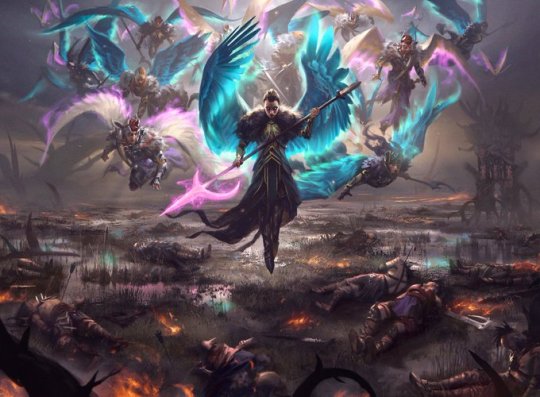
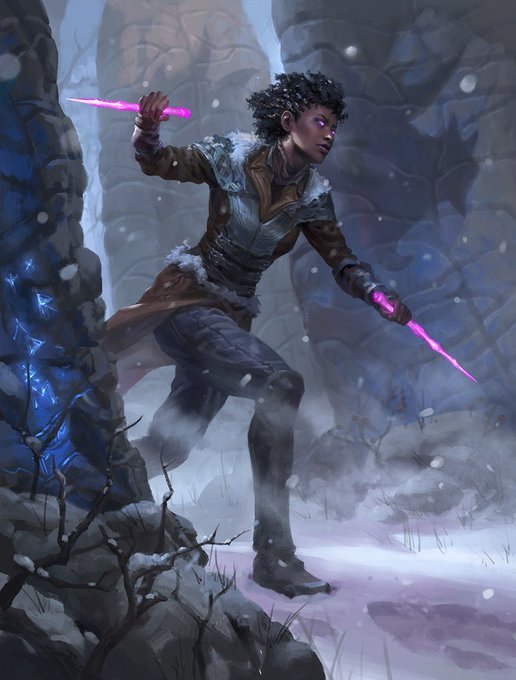
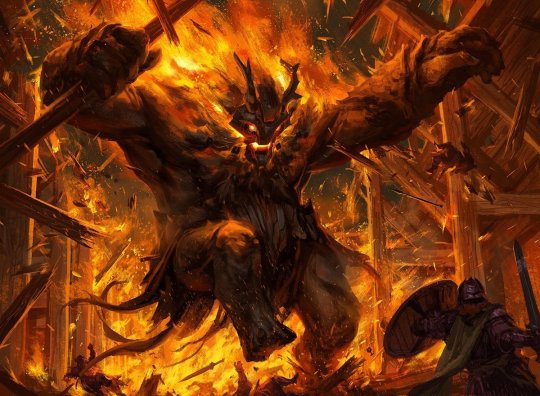
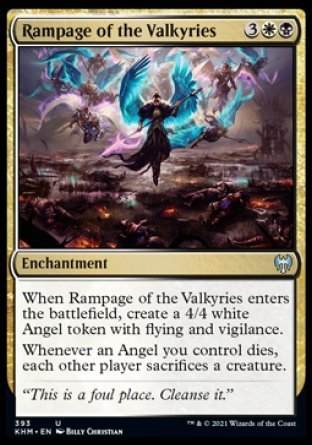
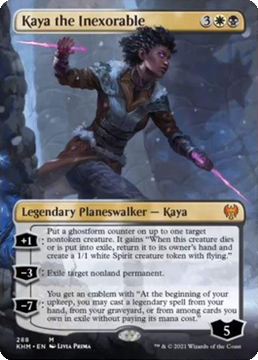
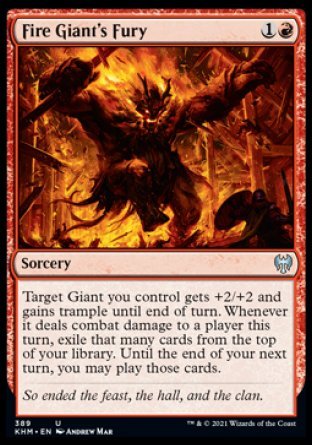
Magic: the Gathering - Kaldheim Previews 12.16
Rampage of the Valkyires, illustrated by Billy Christian
Kaya the Inexorable (extended variant), illustrated by Livia Prima
Fire Giant's Fury, illustrated by Andrew Mar
In Norse mythology, Valkyries were spirits that would fly above the battlefield in search of the dead, deciding the fate of the fallen for Odin. In the two medieval Icelandic works, Poetic Edda and Prose Edda, Valkyrie meant “choosers of the slain" where the heroic warriors would be flown by the Valkyries over Bifrost, the rainbow bridge, and on to the afterlife in Valhalla. What is somewhat sanitized in modern reflections is that the Valkyries were sinister and employed a dark magic. The poem Darraðarljóð is completely / whole lotta gruesome and would likely eclipse any modern horror movie.
The fiery hellscape of Surtr land in Muspelheim is the realm of such giants live such as this always-angry-all-the-time individual.
87 notes
·
View notes
Link
Chapters: 8/?
Fandom: Loki (TV 2021), Marvel Cinematic Universe, Thor (Movies)
Rating: Explicit
Warnings: No Archive Warnings Apply
Relationships: Loki/Sylvie (Loki TV), Loki & Thor (Marvel)
Characters: Loki (Marvel), Sylvie (Loki TV), Thor (Marvel), Frigga | Freyja (Marvel), Odin (Marvel)
Additional Tags: Asgardian Family Drama, Alternate Universe - Canon Divergence, But aren't they all alternate universes now?, Do not leave Loki alone with his thoughts, Angst, Loki & Thor Bro Feels (Marvel), Loki thinks too much, Genderfluid Loki (Marvel), Breaking the Sacred Timeline, When you have changed but your family hasn't, Things get weird
Summary:
When Sylvie pushes Loki through the portal, he ends up back in New York, in what appears to be the Sacred Timeline only moments after he stole the Tesseract.
The web is now woven and the battlefield reddened;
The news of disaster will spread through lands.
It is horrible now to look around
As a blood-red cloud darkens the sky.
The heavens are stained with the blood of men,
As the Valkyries sing their song.
-Darraðarljóð
7 notes
·
View notes
Link
Chapters: 1/?
Fandom: Loki (TV 2021), Marvel Cinematic Universe, Thor (Movies)
Rating: Explicit
Warnings: No Archive Warnings Apply
Relationships: Loki/Sylvie (Loki TV)
Characters: Loki (Marvel), Sylvie (Loki TV), Thor (Marvel), Frigga | Freyja (Marvel), Odin (Marvel)
Additional Tags: Asgardian Family Drama, Alternate Universe - Canon Divergence, But aren't they all alternate universes now?, Do not leave Loki alone with his thoughts, Angst, Loki & Thor Bro Feels (Marvel), Loki thinks too much, Genderfluid Loki (Marvel), Breaking the Sacred Timeline, When you have changed but your family hasn't
Summary:
When Sylvie pushes Loki through the portal, he ends up back in New York, in what appears to be the Sacred Timeline only moments after he stole the Tesseract.
The web is now woven and the battlefield reddened;
The news of disaster will spread through lands.
It is horrible now to look around
As a blood-red cloud darkens the sky.
The heavens are stained with the blood of men,
As the Valkyries sing their song.
-Darraðarljóð
6 notes
·
View notes
Text
Volven
In Norse society, a vǫlva was an elderly woman who had released herself from the strong family bonds that normally surrounded women in Norse clans. She travelled the land, usually followed by a retinue of young people, and she was summoned in times of crisis. She had immense authority and she charged well for her services.
In addition, many aristocratic Viking women wanted to serve Freyja and represent her in Midgard. They married Viking warlords who had Odin as a role model, and they settled in great halls that were earthly representations of Valhalla. In these halls there were magnificent feasts with ritualized meals, and the visiting chieftains can be likened with the einherjar, the fallen warriors who fought bravely and were served drinks by Valkyries. However, the duties of the mistresses were not limited to serving mead to visiting guests, but they were also expected to take part in warfare by manipulating weaving tools magically when their spouses were out in battle. Scholars no longer believe that these women waited passively at home, and there is evidence for their magic activities both in archaeological finds and in Old Norse sources, such as the Darraðarljóð.
Source: Gorm Helge Grønli Rudschinat
#volven#volva#seidr#mistress of seidr#Gorm Helge Grønli Rudschinat#norse medieval history#Gorm Helge Grønli Rudschinat on flickr#norse history#scandinavian history#norse medieval#women in norse history#norse high status women
107 notes
·
View notes
Photo
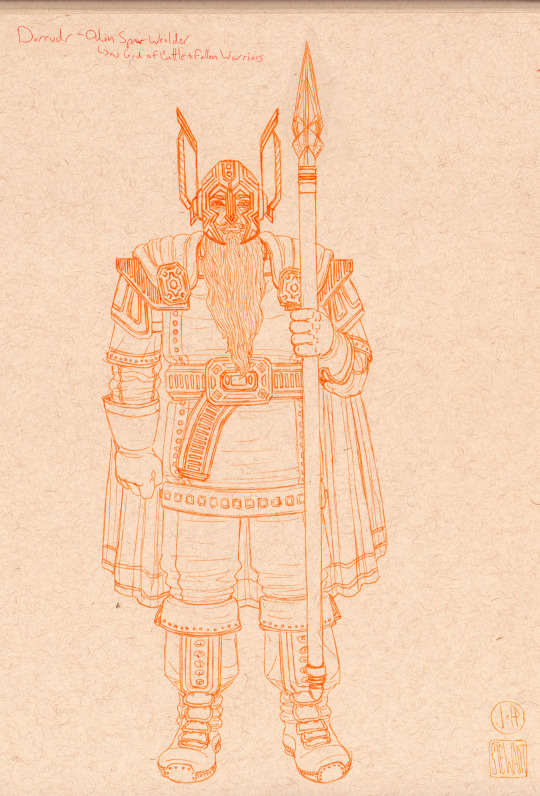
Norsery Rhymes, Northern Mythology from A to Z
Dorrudr / Darradr - Odin, The Weaver of the Spear
Well here we are another Thor’s Day and another 20 min sketch of a Norse (and Germanic, sometimes Celtic) mythological characters. This week it’s Dorrudr / Darradr / Darrað / Dorrað / Dörruðr / Darruðr. Odin in in one of his most warlike aspects. Mentioned in several old sources such as Hofudlausn, Atlakvda, Hakonarmal and Darradarljod.
It’s a word with several differing translations. When related to spears, ”The weaving of the spear”, or “The Woven Spear”. Which could be a reference to Odin creating his magic spear Gungnir from the world tree. Or as “the many interwoven spears”.
Alternately when translated as being related to banners and the flag part of it, the pennant, it’s translated as “the swaying banner”, “The woven banners” and even explained away as all of these together as the woven banners / pennants swaying on the spear.”. “The nailed or riveted pennant” is sometimes mentioned but is believed to be a misunderstanding in interpretation. All of these Spears or Banners together though speak to a gathering of houses and peoples into a single army. Making the Spear and Banner interchangeable as a symbol for the soldiers in that army.
When attributed as Odin’s name it generally is thought to mean “the Weaver of the Spear.” or “the Spear Wielder”, or “The Weaver of the Spearsmen”, or simply “The Spearman”.
In the Darradarljod / Darraðarljóð and Njáls saga, Dorrudr is also described as the one who listens to Valkries. Which opens up the possibility that the weaving of the Valkr is not influencing the battle so much as it is relating the battle to Odin to indicate who should join his army in Valhalla. Or that Odin himself is weaving the battle to bring the right soldier to his army.
As the Valkries are also described as conducting ‘weaving’ of magic apart but during battle, or as a direct part of it, Odin’s mention as Dorrudr is sometimes thought of as he is the weaver of the battle, or the conductor.
The story revolves around Valkries and Odin witnessing a battle. A Viking invasion and great battle that resulted in the defeat of the full Irish forces including the High King and and unidentifed Earl. While there are 12 Valkr mentioned, only six are named. Sanngriðr, Hjörþrimul, Guðr, Hildr, Svipul, and Göndul. They make decisions who will be slain. Either weaving spells, stories, or a loom of fate to do so. At the end carrying away the worthy, with Odin witnessing and departing last.
This is one of the more interesting ones translation and meaning wise. All wrapped up in battle.
For a whole lot more aspects, versions and tales of Odin that I’ve sketched so far, there are probably too many to link here but I can put up another post with all of them later today, and I’ll add a link to that post here when I do.
#Norsemythology#odin#norse#myhtology#dorrudr#darrudr#spear#weaver#banner#pennant#valkr#valkyrie#drawing#sketch#line art#line drawing#concept art#Character Design#character art
2 notes
·
View notes
Link
Chapters: 1/?
Fandom: Loki (TV 2021), Marvel Cinematic Universe, Thor (Movies)
Rating: Explicit
Warnings: No Archive Warnings Apply
Relationships: Loki/Sylvie (Loki TV)
Characters: Loki (Marvel), Sylvie (Loki TV), Thor (Marvel), Frigga | Freyja (Marvel), Odin (Marvel)
Additional Tags: Asgardian Family Drama, Alternate Universe - Canon Divergence, But aren't they all alternate universes now?, Do not leave Loki alone with his thoughts, Angst, Loki & Thor Bro Feels (Marvel), Loki thinks too much, Genderfluid Loki (Marvel), Breaking the Sacred Timeline, When you have changed but your family hasn't
Summary:
When Sylvie pushes Loki through the portal, he ends up back in New York, in what appears to be the Sacred Timeline only moments after he stole the Tesseract.
The web is now woven and the battlefield reddened;
The news of disaster will spread through lands.
It is horrible now to look around
As a blood-red cloud darkens the sky.
The heavens are stained with the blood of men,
As the Valkyries sing their song.
-Darraðarljóð
8 notes
·
View notes
Text
As the Valkyries Sing Their Song
read it on the AO3 at https://ift.tt/3i0tltv
by ClockworkCrow (icemink)
When Sylvie pushes Loki through the portal, he ends up back in New York, in what appears to be the Sacred Timeline only moments after he stole the Tesseract.
The web is now woven and the battlefield reddened;
The news of disaster will spread through lands.
It is horrible now to look around
As a blood-red cloud darkens the sky.
The heavens are stained with the blood of men,
As the Valkyries sing their song.
-Darraðarljóð
Words: 1792, Chapters: 1/?, Language: English
Fandoms: Loki (TV 2021), Marvel Cinematic Universe, Thor (Movies)
Rating: Explicit
Warnings: No Archive Warnings Apply
Categories: F/M
Characters: Loki (Marvel), Sylvie (Loki TV), Thor (Marvel), Frigga | Freyja (Marvel), Odin (Marvel)
Relationships: Loki/Sylvie (Loki TV)
Additional Tags: Asgardian Family Drama, Alternate Universe - Canon Divergence, But aren't they all alternate universes now?, Do not leave Loki alone with his thoughts, Angst, Loki & Thor Bro Feels (Marvel), Loki thinks too much, Genderfluid Loki (Marvel), Breaking the Sacred Timeline, When you have changed but your family hasn't
read it on the AO3 at https://ift.tt/3i0tltv
0 notes
